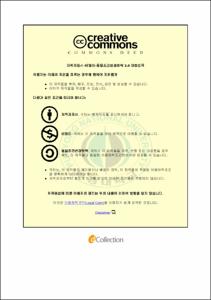외란을 가지는 무인운송차량의 제어에 관한 연구
- Alternative Title
- A Study on Control of Automated Guide Vehicle with Disturbance
- Abstract
- Today, automatic guided vehicle(AGV) is used for security, safe, transportation, inspection, exploration, and scientific experiments in several fields such as factories, ports, hospitals, farms, military, and so on. Several control algorithms for trajectory tracking, path-following and point stability of the AGV has been reported. They are not enough to control the AGV in practical fields with uncertain disturbances. To solve this problem, new control algorithms for AGV with two driving wheels in the presence of uncertain bounded disturbance are needed.
This dissertation is to present methods to control a two-wheeled AGV with the unknown bounded disturbance to track a given reference with constant velocity using USB camera. To do this work, first, a two-wheeled AGV is designed. The AGV consists of body, two driving wheels, two casters to balance the body, control system and sensors.
Second, kinematic modeling for a two-wheeled AGV under constraint conditions of no slip and pure roll and its dynamic modeling based on Lagrange formula considering the uncertain bounded disturbance are presented.
Third, based on the modelings, two controllers are designed to control AGV with the uncertain bounded disturbance to track a given reference with constant velocity. One is an input-output feedback linearization controller to track a straight line with constant velocity. Another is a sliding mode controller designed by a sliding mode method to track a straight line and a curved line with constant velocity. For AGV with uncertain bounded disturbance, the input-output feedback linearization controller is designed using the time derivative of acceleration of two wheels as input and the shortest distance from a tracking point on AGV to the reference straight line and linear velocity of AGV as outputs. The input-output feedback linearization controller is designed to linearize the dynamic modeling using the input-output of AGV. This controller makes the overall system of the AGV into two linearized decoupled systems completely. A tracking error vector is defined. The tracking error vector consists of a position error between the real shortest distance and the desired shortest distance, and a velocity error between the real velocity and the desired linear velocity. Based on the linearized dynamic modelings, a new control input vector is proposed to make the tracking error vector go to zero. The sliding mode controller is proposed to make a sliding vector go to zero. Based on the modelings, a tracking error vector is defined. Using kinematic modeling, a desired velocity control input as a kinematic control law is designed by Lyapunov stability theory to track the reference curved line. A velocity error vector is defined as the difference between the real velocity vector of the AGV and the desired velocity vector of the kinematic control law. A sliding surface vector is chosen and consists of the tracking error vector and the velocity error vector. Based on the dynamic modeling, a sliding mode controller is designed to the sliding surface vector go to zero by Lyapunov stability theory.
Fourth, schemes to detect the factors to computer these controllers are presented, and equations to detect them from the schemes are obtained. Using the equations, the designed controllers are computed. Torques of two wheels are generated to track the reference line with the desired velocity by the computed controllers.
Fifth, to implement the controllers, a control system integrating notebook computer for processing images obtained from USB camera and Microcontroller PIC28F452 is developed. USB camera sensors, motor encoders and one bottom encoder are used to obtain the information of factors for implementing the proposed controllers. And AGV is developed to experiment it.
Finally, to show the effectiveness and applicability of the proposed controllers, simulation and experiments are shown.
It is shown that the sliding mode controller is better to track the given reference lines than a controller designed by the input-output feedback linearization controller.
- Issued Date
- 2010
- Awarded Date
- 2010. 2
- Type
- Dissertation
- Publisher
- 부경대학교
- Affiliation
- 부경대학교 대학원
- Department
- 대학원 메카트로닉스공학협동과정
- Advisor
- 김상봉
- Table Of Contents
- 목 차 i
Abstract iii
제 1 장 서 론 1
1.1 연구 배경 및 동기 1
1.2 연구 목적 및 방법 8
1.3 연구 내용 및 내용 10
제 2 장 AGV 시스템의 구성 및 모델링 12
2.1 AGV 시스템 12
2.2 AGV의 운동방정식 14
2.2.1 AGV 운동학적 모델 16
2.2.2 AGV 동력학적 모델 21
제 3 장 AGV의 제어기 설계 30
3.1 입출력 선형화 제어기 설계 30
3.2 슬라이딩모드 제어기 설계 37
제 4 장 제어기의 구현 45
4.1 제어기 구현에 필요한 인자 검출기법 45
4.2 제어시스템의 구성 47
제 5 장 시뮬레이션 및 실험결과 51
5.1 입출력 선형화 제어기의 시뮬레이션 및 실험결과 51
5.2 슬라이딩모드 제어기의 시뮬레이션 및 실험결과 60
제 6 장 결론 72
References 75
Publications and Conferences 86
부록 88
부록 A 식(3.18)~식(3.20) 증명 88
부록 B 하드웨어 92
부록 C 회로도 102
감사의 말씀 104
- Degree
- Doctor
- Appears in Collections:
- 대학원 > 메카트로닉스공학협동과정
- Files in This Item:
-
-
Download
 외란을 가지는 무인운송차량의 제어에 관한 연구.pdf
기타 데이터 / 3.93 MB / Adobe PDF
외란을 가지는 무인운송차량의 제어에 관한 연구.pdf
기타 데이터 / 3.93 MB / Adobe PDF
-
Items in Repository are protected by copyright, with all rights reserved, unless otherwise indicated.